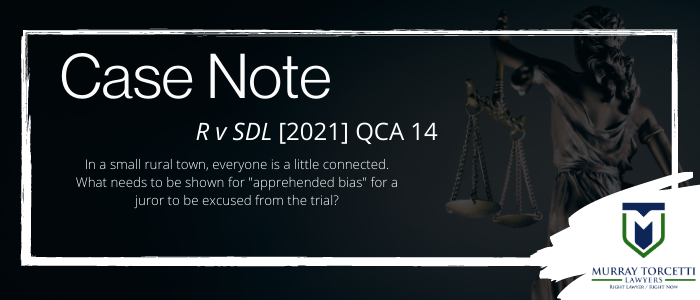Murray Torcetti Lawyers are criminal lawyers in Caboolture. We write our own case notes from recent criminal decisions for internal purposes. However, unlike your annoying sibling, we don’t mind sharing.
Facts: In a small rural town, the defendant was found guilty of one count of maintaining a sexual relationship after a three-day trial. The appellant recognised the names of 11 people in the jury pool, the judge declined to excuse those people leaving it to the Prosecution to challenge the jurors, of the 11, 10 were challenged with the 11th being empanelled as “Juror 4”.
A pre-recording of the evidence was played to the jury. After a break it was raised with the judge the appellant recognised Juror 4 as “as the brother of an associate of the appellant.” The contact was limited to a “”G’day” 7 years prior. The juror was taken into court in the absence of the remaining jurors, when asked about possible contact with the appellant, Juror 4 could not recall meeting the appellant.
The judge only discharged the single juror for potential perceived bias and proceeded with 11 jurors. Both defence and prosecution sought a discharge of the full jury. Relying on the test in Wu v The Queen (1999) 199 CLR 99, the judge noted the delay in the matter reaching trial and costs attached to starting with a new jury.
(There was a further ground of admissibility of preliminary complaint evidence that was unsuccessful not addressed in this case note).
Finding: For apprehended bias to exist, there needs to be a basis. There were no grounds for the judge to discharge juror number 4 pursuant to s 56(1)(a) of the Jury Act 1995.There was a miscarriage of justice in denial to the appellant of the right to be tried by a jury of 12 persons.
When looking at the thin connection between the appellant and Juror 4, Justice Mullins applied the test of “apprehended bias” in Ebner v Official Trustee in Bankruptcy (2000) 205 CLR 337 at [6]
“is expressed in terms that a decision-maker “is disqualified if a fair-minded lay observer might reasonably apprehend that the [decision-maker] might not bring an impartial mind to the resolution of the question” and “that there has to be identification of the connection that might lead the juror to decide the case other than on its legal and factual merits and an articulation of the logical connection between that matter and the apprehended deviation from the course of deciding the case on its merits”
Notes for practice:
- In the event a juror is discharged, take further instructions on if to proceed or press for a new trial.
- The statement and application of the law of “apprehended bias”
Because lawyers love a good disclaimer – here is ours – It boils down to: If you need legal advice see a lawyer. Dr Google isn’t going to prescribe you meds if you are sick, Google LLB isn’t going to give you advice or information specific to your situation.
If you need legal assistance. See a lawyer.
You might not read it, but we will rely on it if you try and sue us (smug face).
